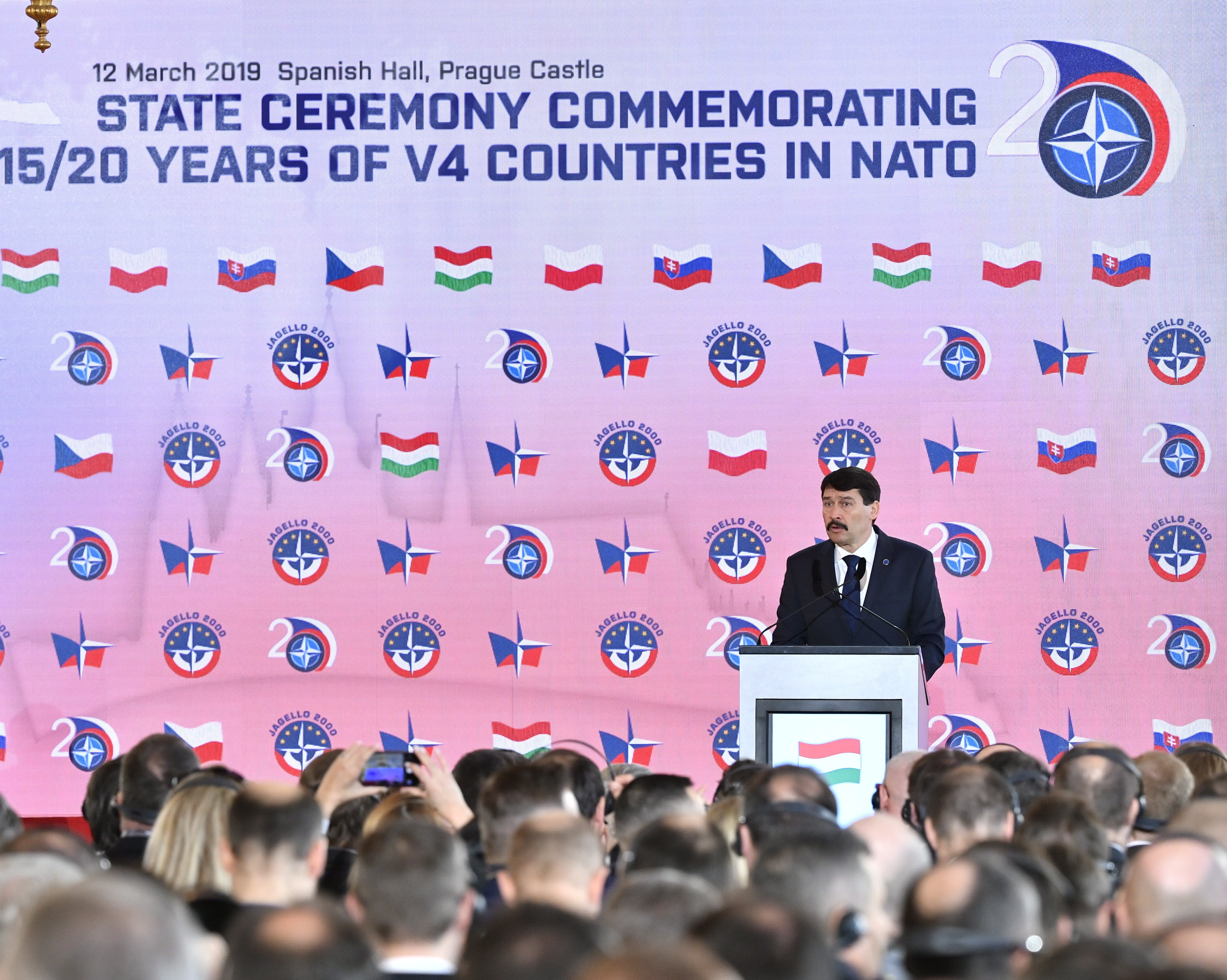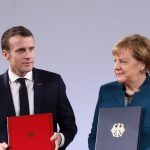THE WARSAW INSTITUTE REVIEW
Date: 5 July 2019 Author: Juraj Krupa
Visegrad Four Defense Cooperation: Years of Missed Opportunities
Since the establishment of the Visegrad Four in the early 1990s, most of the leaders and experts expected that, due to similar situations in almost all areas of life in those countries, the cooperation of V4 countries would naturally flourish in all domains, including the areas of security and defense. Since all V4 countries have Warsaw pact armies’ heritage and the same desire of Euro-Atlantic integration, their significant projects in the area of defense were expected to become successful. Although the idea of such a defense cooperation is supported by the authorities along with relatively high ambitions emphasized by many common declarations, the expectations and its potential have not been fulfilled. There were some partial successes, however, the existence of which leaves hope for tangible and more ambitious projects in the future.
 HUNGARIAN PRESIDENT JANOS ADER ADDRESSES A CEREMONY MARKING THE 20TH ANNIVERSARY OF THE ACCESSION OF THE CZECH REPUBLIC AND THE REST OF THE VISEGRAD FOUR (V4) COUNTRIES INCLUDING HUNGARY, POLAND AND SLOVAKIA TO THE NORTH ATLANTIC TREATY ORGANIZATION (NATO), IN PRAGUE, CZECH REPUBLIC, 12 MARCH. © ZSOLT SZIGETVARY (PAP/EPA)
HUNGARIAN PRESIDENT JANOS ADER ADDRESSES A CEREMONY MARKING THE 20TH ANNIVERSARY OF THE ACCESSION OF THE CZECH REPUBLIC AND THE REST OF THE VISEGRAD FOUR (V4) COUNTRIES INCLUDING HUNGARY, POLAND AND SLOVAKIA TO THE NORTH ATLANTIC TREATY ORGANIZATION (NATO), IN PRAGUE, CZECH REPUBLIC, 12 MARCH. © ZSOLT SZIGETVARY (PAP/EPA)Particular national interests and ongoing changes in the political process of Central European countries influence V4 defense cooperation. Certain countries in Central Europe seem to be fading away from democracy and liberalism for various reasons, which results in increased vulnerability for external influences and threats. This change in political discourse has an impact on their ability to share common values and principles and gives more ground to disintegration tendencies and particular ambitions. Geopolitical initiatives like the Tree Seas Initiative might have a negative impact on security and stability in the region when used as a foreign policy tool in disputes with other EU members. This is especially true in Central Europe, a region that has historically suffered greatly following changes in the balance of power or geopolitical games.
Pro-Americanism was the unquestioned foreign policy principle in Central Europe until 2014. This is not the case anymore. It is not that the region has become openly anti-American but rather its elites and the public have lost interest in the United States, just as interest in Central and Eastern Europe has disappeared in Washington. This migration away from Central Europe is not new, however, and has been gradually ongoing as a result of growing American interests in Asia. Although this is not the case for Poland, it is already a fact for other Central European countries.
All V4 countries officially declare to be reliable allies with no alternative to NATO membership, but their attitudes towards NATO policies and fulfilling its goals are starting to differ. Hungary´s perception of threat focuses on migration and this country keeps close relations with Russia. The political landscape in the Czech Republic and Slovakia are shaped by populism and they would like to play a role of a mediator between Russia and the West. Poland, on the other hand, sees Russia as the main threat.
Political differences, along with particular national interests, are seen in the V4 defense cooperation. This cooperation is formally presented as successful; however, no major project has so far been accomplished. Such projects as the EU BG V4 cooperation or JLSG would not be achieved without the European Union.
So far, the V4 defense cooperation has caused many disappointments and missed opportunities. To date, joint acquisition of systems that would be used by multiple V4 countries has not yet occurred. Many activities and projects, which have been started, have failed to fulfill expectations. Some were stopped while others are still running only on paper, without any tangible effects. The list of unfinished projects is long. Most of them were in the area of common acquisitions, modernization, and R&D. A CEPI policy paper lists a number of projects announced in public by political leaders that did not get anywhere[1]:
Mobile 3D radars is a project stemming from 2013, which had the aim to develop modern radars that would provide air protection and surveillance capability for V4 countries. A memorandum of understanding was signed in 2014 by defense industry companies interested in participating in the project. At the time, all V4 countries were planning to acquire new radars, and this project seemed to have not only political support but also common interest. After a promising start of negotiations, the project was stopped due to different national interests and timelines in acquiring new radars. The final result was that all countries were blaming each other for favoring national interests over the success of the project.
R&D and acquisition of Rosomak APCs started in 2015 with the support of both prime ministers of Poland and Slovakia. The APC is being produced under the license of a Finnish company Patria in Poland. The prototype has even been presented during the IDET Expo in the Czech Republic in 2015 under the brand Rosomak/Scipio. Due to budgetary issues of the Slovak Defense Ministry, the Slovak side offered to modernize self-propelled Howitzers Dana, Tanks, and Canons to the Polish armed forces. After months of complicated negotiations between both sides, the project has been dropped with both sides blaming each other for the lack of flexibility in finding a suitable compromise. The Slovak side, with its insufficient resources, was not able to provide enough financial coverage, while the Polish side was constantly coming up with new requirements (engines for MiG-29, etc.), which could not be fulfilled by Slovakia.
Modernization of helicopters has been identified as a need by all V4 countries already in the 1990s. Many new ideas and projects have been introduced since then – multinational aviation training center, for example – but without success. In the meantime, the countries launched their own programs for acquiring new helicopters. Each country decided to purchase different types of helicopters, which excluded future cooperation in this area. Such situations are symptomatic for many V4 modernization projects.
These examples show a problem in overcoming national interests in common acquisition projects that, if successful, would be favorable for all V4 members. Missed opportunities were not only in the area of modernization and acquisition projects but also in most other attempts in pursuing defense cooperation.
Even though there was progress made in improving common exercises, to date, no improvement in common education has been achieved. Taking into consideration that there is almost no language barrier between Slovakia and the Czech Republic and both countries used to have a unified education system, it is surprising that not a single project in this area has been finalized. Real cooperation between V4 military academies is non-existent despite the signed in 2013 V4 MILEP agreement. As the example of the Baltic countries shows, with political will, and a proper evaluation of the relevance of several education institutions, it is possible to improve education and eliminate duplications – which leads to the cost-saving on infrastructure and staff and bring closer officers from all V4 countries. However, the vision of a V4 academy is currently unreal[2].
Despite the progress in cyberdefense capabilities and cooperation among Allies and within NATO itself, V4 has not been able to improve cooperation in this area. The cyberinfrastructure of the V4 countries is closely interconnected, and its protection requires closer cooperation. Cooperation in cyberdefense, which includes the exchange of industry information as well as common training and assistance, is absent. This should logically lead to at least some discussions on developing V4 cooperation.
Despite these missed opportunities and unsuccessful projects, substantial cooperation in defense area can be achieved. Some initiatives have been partially implemented and have the potential to contribute to improving defense cooperation in the long-term perspective.
One possible way to improve cooperation is to establish a V4 institutional framework that would also contribute to better branding and elevate the status of the region. With the establishment of the so-called Senior Body in 2014, the first precondition for such a framework has been established. Its objective is to coordinate various working groups, joint positions, and projects. This helped to better coordinate the positions of V4 countries within NATO and the EU. Despite its positive role, the Senior Body is largely considered to engage in duplicate work, competing with V4 political director meetings.
One of the biggest flagships of V4 cooperation is the establishment of V4 EU BG “Battlegroup” (operational in 2016). The V4 decided to keep the Battlegroup as a permanent unit after its operationalization as it was deemed to be mutually beneficial. The V4 also agreed to prepare this permanent operationalization in the second half of 2019. The V4 EU BG is one of the maindrivers for improving interoperability and joint defense development of the four central European countries and is also highly valued by the EU and NATO. With the accession of Croatia to the second V4 EU BG in 2019 and its preparedness for potential participation of other allies and partner countries in the region, the V4 members already started discussions about the next operationalization of the Battlegroup expected in 2023[3].
An important precondition for continuous cooperation is the establishment of V4 Joint Logistic Support Group Headquarters (JLSG HQ) that, in the context of lessons learned from the past, could be considered a milestone. The Memorandum of Understanding signed in Budapest in 2018, expects the group to achieve low operational readiness in 2020 and full operational readiness in 2023. If the JLSG HQ will be concluded as planned, it will provide important support to joint military exercises, logistics for the V4 Battlegroup and might also, in some cases, coordinate defense procurement[4].
The development of common protection of the V4 airspace through Cross-Border operations could be another successful project as well. Negotiations have been taking place for years without any substantial progress among the V4 countries. Slovakia and the Czech Republic finalized a Cross-Border agreement in 2018 which could be used as a blueprint for further negotiations with other V4 countries. However, this project was undermined by Slovakia after the government released statements against air policing cooperating with the Czech Republic and Poland. Slovakia also made other arguments against the presence of NATO troops in Slovakia. On the other side, Poland and Hungary are also providing legal barriers that are unnecessarily prolonging the finalization of the agreement.
Major progress has been achieved in the area of joint V4 exercises that are also supported by NATO and the US through the European Deterrence Initiative and are conducted on qualitatively higher level thanks to the attitudes of all of the Armed Forces General Staffs. It adopted the decision to conduct one major exercise and some specialized annually. Regular participation of US troops and other allies are providing higher added value to the quality of the exercises[5].
With the change in the security environment in and around Europe stemming from the assertive behavior and hybrid warfare by Russia, coupled with the issues of migration, terrorism and failed states, the V4 countries should put more effort towards closer cooperation in the area of security and defense. Unfortunately, the types of threats to each central European country are beginning to differ, what is also having an impact on specific projects that could help improve defense cooperation. Thanks to NATO and the EU, the V4 countries are participating in projects that are helping overcome these differences, but so far none of the V4 countries was able to put forward a project that would bring the V4 countries closer together in areas of interoperability, concrete defense planning and acquisitions. Therefore, more effort should be put forward in finding common ground towards addressing new threats jointly with our allies in NATO and the EU.
To be more successful in defense cooperation, some basic criteria must be met:
Similar political culture and goals:All V4 countries should try to make an attempt to undertake decisions that would confirm our allegiance to the values of NATO and the EU. This would again create common ground for real cooperation and projects based on fundamental criteria. This will also provide preconditions for the deployment of combined forces, pooling and sharing of resources while offering cost savings in the area of interconnected defense planning.
Trust and reliability: Partners should build trust to ensure projects will be completed and finalized in a timely manner so that the armed forces of a single partner will not be adversely affected by the withdrawal by the other partners[6].
Interoperability: Despite having NATO membership for 20 years (15 years for Slovakia), most V4 countries failed to invest in expanding and modernizing their armed forces. The armed forces in each V4 country are in a different stage of modernization and use different equipment, making joint operations difficult.
Ability to coordinate defense policy and planning: All V4 countries are part of the NATO defense planning process, and three out of four also have NATO Force Integration Units in their countries. Despite meeting all preconditions for closer defense planning cooperation, no progress has been achieved so far and no signs of positive development can be seen on the horizon[7].
Cooperation among V4 countries is of vital importance despite often different views on fundamental principles and national interests. The V4 group is geographically, politically and economically determined to cooperate, the fact of which is relevant for defense cooperation. The cooperation should focus more on practical projects, which do not necessarily have to be big. The aim should be to focus more on assistance, effective cooperation, and smaller projects with added value. Big projects could “sell the brand,” but smaller projects might be more beneficial, overall.
[1]DAV4 po piatich rokoch: úspech alebo nevyužitá príležitosť, 2015, Jaroslav Naď, Milan Šuplata, Marian Majer.
[2]http://www.visegradgroup.eu/calendar/2012/joint-communique-of-the, 2012, Joint Communiqué of the Ministers of Defense of the Visegrad Group
[3]http://www.visegradgroup.eu/calendar/2014/budapest-declaration-of, 2014, Budapest Declaration of the Visegrad Group Heads of Government on the New Opening in V4 Defense Cooperation
[4]http://www.mocr.army.cz/informacni-servis/zpravodajstvi/seniorni-skupina-v4-jednala-v-budapesti-o-bezpecnostni-a-obranne-politice-eu-141535/, 2018, Seniorní skupina V4 jednala v Budapešti o bezpečnostní a obranné politice EU
[5]https://www.vlada.gov.sk//martin-glvac-posilnujeme-regionalnu-obrannu-spolupracu-v4-cvici-spolocne/?pg=2, 2016, Martin Glváč: Posilňujeme regionálnu obrannú spoluprácu: V4 cvičí spoločne.
[6]https://www.files.ethz.ch/isn/156487/Towards%20a%20Deeper%20Visegrad%20Defense%20Partnership.pdf, 2012, DAV4 Full report, Towards a deeper Visegrad defense partnership, Jozef Bátora, Gareth Chapell, Attila Demkó, Amb. István Gzarmati, Jan Jireš, Amb. Rastislav Káčer, Jiří Schneider, Amb. Jiří Šedivý, Marcin Terlikowski, Gen. László Tombol, Tomáš Valášek, Marcin Zaborowski.
[7]http://www.visegradgroup.eu/about/cooperation/defence, 2013, For a More Effective and Stronger Common Security and Defense Policy.
_________________________________
All texts published by the Warsaw Institute Foundation may be disseminated on the condition that their origin is credited. Images may not be used without permission.














